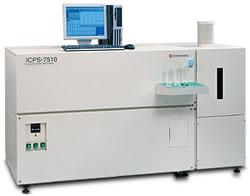|
Instrument Database:
Shimadzu Corporation - ICPS-7510 Sequential Plasma Emission Spectrometer
| |
|

|
| |
|
| |
|
| Year of introduction |
|
| Status |
available |
| Company |
Shimadzu Corporation
|
| Categories |
Spectrometer ( Atom. ): AES: ICP-AES
|
The important features of the ICP are: - Detection limit of ppb quantity level.
- No matrix effect.
- Wide measurable concentration range.
- High stability and reproducibility.
With these and many other advantages, ICP spectrometers are widely used; their application fields include elemental analysis for quality control, ultratrace element determination such as for environmental water quality monitoring, and major element determination such as for composition determination.
In order for an ICP spectrometer to get the maximum use of the above features, it is required that: - The spectrometer provides high resolution over a wide wavelength range.
- Acidic/aqueous solution samples and organic solvent solution samples can be analyzed without addition or replacement of the units of the instrument.
- The RF generator, spectrometer, and gas flow control unit ensure high stability.
- Running cost is low.
- Ease and simplicity of operation are ensured through automation, and the data system provides a wide variety of data processing functions.
The Shimadzu ICPS-7510 is the latest, sequential, inductively coupled plasma emission spectrometer designed to satisfy all of these requirements.
Large database and many software programs are readily available.
|
| Specifications |
|
| Optical system | Czerny-Turner mounting. | | Double grating | | Focal length | 1000mm | | No. of diffraction grating grooves and wavelength range | 3600 grooves/mm for 160 to 458 mm | | 1800 grooves/mm for 458 to 850 mm | | Reciprocal dispersion | 0.22nm/mm(3600groves) | | 0.44nm/mm(1800groves) | | Detector | Photo-multiplier tube | | Slit | Entrance slit 20µm | | Exit slit 30µm | | Wavelength scanning | Sine-bar method | | Driven by a computer controlled pulse motor | | Minimum step wavelength 0.0002nm | | Maximum speed 50nm/sec (3600 grooves) | | Temperature control | Proportional control method 38°C±0.1℃ | | Exhaust system | Rotary pump exhaust capability 160 liters/minute | | With oil backflow prevention valve |
ICP Light source | Torch unit | Cyclone chamber (misting chamber) | | Quartz plasma torch | | Coaxial type nebulizer | | Observation position switching | Up and down, 2 steps (during radial observation) | | Gas controller | 3 plasma flow channels | | Flow rate setting range (computer controlled) | | Coolant gas 2 to 20liters/minute | | Plasma gas 0.2 to 1.4liters/minute | | Carrier gas 0.1 to 1.5liters/minute | | Purge gas 3.5liters/minute | | Axial observation attachment | Direction of observation can be changed (radial/axial) |
Radio frequency generator | Oscillator | Crystal oscillator | | Frequency | 27.120MHz ±0.05% (ISM band) | | Output | 0.8, 1.0, 1.2, 1.4, 1.6, 1.8kW | | Output stability | Within ±0.3% | | Radio frequency circuit element | Transistor | | Ignition method | Fully automatic ignition | | Load matching | Automatic matching (auto tuning) | | With safety function | Radio frequency generator temperature fault detection |
Photometry and control | Negative high voltage power supply | Variable 16 steps | | Photometric method | Sequential element measurement method | | Dynamic range | 9 figures |
Data processor
Personal computer | CPU | Intel Celeron 2.0GHz or higher | | Memory | Main memory: RAM 64MB | | External memory device | 1 CD-ROM installed | | 3.5 inch floppy disc unit, 1 drive built-in | | Hard disk over 40GB | | Display | 15 inch color TFT | | Printer (option) | Monochrome laser printer
Matrix inkjet printer |
|---|
|
Related links:
|